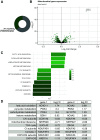Functional and molecular profiling of fasted piglets reveals decreased energy metabolic function and cell proliferation in the small intestine
- PMID: 37847725
- PMCID: PMC10894671
- DOI: 10.1152/ajpgi.00240.2022
Functional and molecular profiling of fasted piglets reveals decreased energy metabolic function and cell proliferation in the small intestine
Abstract
The small intestine requires energy to exert its important role in nutrient uptake and barrier function. Pigs are an important source of food and a model for humans. Young piglets and infants can suffer from periods of insufficient food intake. Whether this functionally affects the small intestinal epithelial cell (IEC) metabolic capacity and how this may be associated with an increased vulnerability to intestinal disease is unknown. We therefore performed a 48-h fasting intervention in young piglets. After feeding a standard weaning diet for 2 wk, 6-wk-old piglets (n = 16/group) were fasted for 48 h, and midjejunal IECs were collected upon euthanasia. Functional metabolism of isolated IECs was analyzed with the Seahorse XF analyzer and gene expression was assessed using RNA-sequencing. Fasting decreased the mitochondrial and glycolytic function of the IECs by 50% and 45%, respectively (P < 0.0001), signifying that overall metabolic function was decreased. The RNA-sequencing results corroborated our functional metabolic measurements, showing that particularly pathways related to mitochondrial energy production were decreased. Besides oxidative metabolic pathways, decreased cell-cycle progression pathways were most regulated in the fasted piglets, which were confirmed by 43% reduction of Ki67-stained cells (P < 0.05). Finally, the expression of barrier function genes was reduced upon fasting. In conclusion, we found that the decreased IEC energy metabolic function in response to fasting is supported by a decreased gene expression of mitochondrial pathways and is likely linked to the observed decreased intestinal cell proliferation and barrier function, providing insight into the vulnerability of piglets, and infants, to decreased food intake.NEW & NOTEWORTHY Fasting is identified as one of the underlying causes potentiating diarrhea development, both in piglets and humans. With this study, we demonstrate that fasting decreases the metabolism of intestinal epithelial cells, on a functional and transcriptional level. Transcriptional and histological data also show decreased intestinal cell proliferation. As such, fasting-induced intestinal energy shortage could contribute to intestinal dysfunction upon fasting.
Keywords: cell proliferation; fasting; intestine; metabolic function; mitochondria.
Conflict of interest statement
No conflicts of interest, financial or otherwise, are declared by the authors.
Figures








References
Publication types
MeSH terms
Substances
Grants and funding
LinkOut - more resources
Full Text Sources
Molecular Biology Databases
Research Materials

